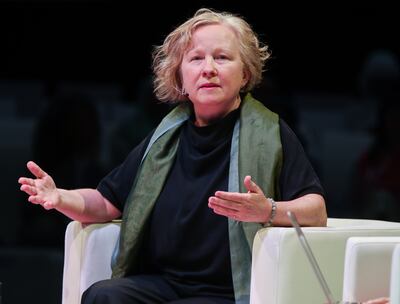Two climate activists were this week sentenced to time in prison by a Dutch court for targeting Johannes Vermeer's Girl with a Pearl Earring.
It is the latest in a string of acts carried out by climate activists on beloved masterpieces. NYU Abu Dhabi staff Maya Allison, chief curator, and Joanna Settle, associate dean, faculty affairs and social impact, and arts professor of theatre, discuss the motivations behind these activities and the impact they're having on the art world.
Maya Allison

“I want to start by making very clear that I am in no way in favour of attacking art or museums. This is very stressful for those who work in such institutions, and could lead to actual damage of art, which I do not support. My thoughts below are with regard to the tomato soup on the glass frame in particular.
"If you run an internet search for 'van Gogh tomato soup' right now, these questions pop up in Google’s quick summary: Why did they throw soup on the painting? Why are people throwing food at paintings? Who funds Just Stop Oil? Who threw soup at a painting?
"In the past weeks, we have seen protesters throw tomato soup at van Gogh’s Sunflowers painting, and then another duo poured mashed potatoes on a Monet painting. Both of these are priceless works of art. Both are protected by glass.
"This news cycle brings to my mind two things, as they relate to art.
"First, iconoclasm: this is the term that means 'to destroy icons' — it has applied, in the past, to religiously motivated destruction of works of art, but also to nonconformists who challenge beliefs or institutions. In both cases, the painting was behind glass, and there was no damage to the van Gogh or the Monet.
"These acts were not destruction of art. But in both cases they were a challenge to beliefs and institutions, in current financial systems: one of the tomato soup-throwers said that they were doing it to call attention to 'the current cost of living crisis in the UK with growing concerns about the cost of energy' and to urge leaders to invest in renewable energy.
"The second thing the van Gogh event brings to my art curator mind, in particular, is Andy Warhol. He is credited with starting the pop art movement, and most famous for his images of Campbell’s Tomato Soup cans. He also coined the term 'Business Art' to describe his more conceptual works.
"There are two parallels here, almost like art historical rhymes: Andy Warhol put tomato soup cans on the wall and called them art, and these protesters threw tomato soup onto art and called it a protest of business; Andy Warhol understood business and finance as conceptual art material, these artists are using their actions to activate media awareness of financial challenges.
"Their actions deftly link the history of iconoclasm, pop art, and conceptual art to the most pressing concerns of the day — the link between our very existence and our business models.
Joanna Settle

"I love this point you are making about 'business art'. Certainly, performance across music, theatre and dance is big business. But performances are also workshops to experiment with who we want to be, and how we treat each other. In theatre, we enact an extreme circumstance: the events of a play are typically 'a day like no other.'
"Then, the artists and audience together wonder 'what would I do in that situation' or 'let me see how they solve this, I'm having the same issue.'
Conversations around protest often devolve into the stale 'I agree with their message but not with their methods.' But do you believe human extinction is at hand, and preventable? If so, then what do you do?
"The artists/activists who threw the tomato soup on a van Gogh — or more accurately, on the glass protecting a van Gogh — followed that gesture by gluing their hands to the wall. In theatre, we spend a lot of time creating rehearsal environments that allow the artists to feel safe while working on challenging material.
"My first thought seeing this gluing gesture was that the National Gallery in London was doing something right. These young people, Phoebe Plummer and Anna Holland, with researched perspectives and passion, felt safe experimenting at the museum.
"They knew this environment would garner media attention and they were correct, but perhaps they also instinctively expected to be treated humanely by an arts institution. At their best, arts organisations provide sanctuary for bold ideas and developing perspectives, dynamically engaging the public while incubating contemporary culture. Today, do people want to see the van Gogh, or would the museum increase attendance by leaving the tomato soup in place? I’m not sure."













